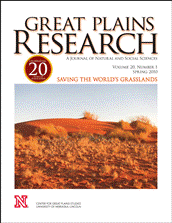Great Plains Studies, Center for

Great Plains Research: A Journal of Natural and Social Sciences (through 2013)
Date of this Version
May 1996
Document Type
Article
Abstract
Canadians mythologize the aesthetics and importance of canoe travel in their nation s development. However, on the Plains, the canoe proved a far from ideal transport mode. The navigation history of a typical small northern Plains river, the Qu'Appelle, illustrates the problems European canoeists faced on the Plains. Key problems included inadequate wood supplies, highly seasonal and variable river flows, meandering rivers, and the lack of feasible portages between major watersheds. Additional handicaps, dangerous in combination, were restricted visibility while canoeing and poor relations with Plains Indian nations. Retracing the forgotten Qu’Appelle river fur trading route confirmed historical evidence of the canoe’s short comings. That the canoe was employed to the extent it was may reflect the slow adaptation of woodland fur traders to Plains travel.


Comments
Published in Great Plains Research 6:1 (Spring 1996). Copyright © 1996 The Center for Great Plains Studies, University of Nebraska–Lincoln. Used by permission. http://www.unl.edu/plains/publications/GPR/gpr.shtml